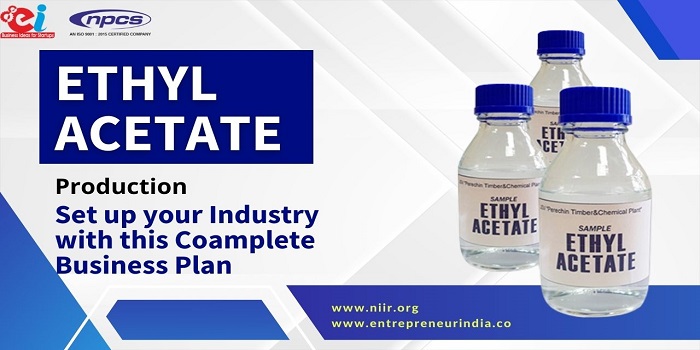There will always be a demand for ethyl acetate as the globe continues to grow and produce new products. It’s a versatile chemical that may be utilised in both industrial and consumer applications, making it one of the most desired chemicals on the market.
To profit from this, start your own Ethyl Acetate Manufacturing business. In this piece, we’ll explain why you should.
Related Feasibility Study Reports: Chemicals (Organic, Inorganic, Industrial) Projects
Ethyl Acetate:
Ethyl acetate is a liquid commonly used as a solvent, either pure or in mixtures. Ethyl acetate is generally recognized as safe by many regulatory agencies and is not listed as an irritant or known carcinogen.
It is found naturally in some fruits, such as apples and bananas. It can also be synthesized from ethanol and acetic acid (CH3COOH). In fact, it is one of three main products when Ethanol is fermented.
Visit this Page for More Information: Start a Business in Chemical Industry Projects
Uses of Ethyl acetate:
In perfumes, cosmetics and deodorants, it acts as a solvent or fixative. In paint removers, it serves to thin oil-based paints; in nail polish removers, to dissolve lacquers; and in adhesives such as rubber cement, to dilute resins.
In metalworking fluids, it reduces viscosity of water-based muds used for drilling steel pipes. Ethyl acetate can also be found in household cleaners, where it functions as an antimicrobial agent.
Manufacturing Process:
Ethyl acetate is made by combining ethanol and acetic acid in a procedure known as esterification. Both chemicals are dissolved in their pure state in an organic solvent such as methyl tert-butyl ether in a process known as transesterification (MTBE).
They are allowed to react with each other at moderate temperatures (about 30 degrees Celsius) and under pressure. The final solution is primarily ethyl acetate, with a little water and traces of acetic acid and ethanol thrown in for good measure.
After that, the mixture is distilled to remove the contaminants from the ethyl acetate. It can be refined further after distillation by putting it through activated carbon filters. It can also go through vacuum distillation or recrystallization operations to ensure purity.
Download PDF: Ethyl Acetate Production Plant. Highly Profitable Business for Entrepreneurs
Why you should start an Ethyl Acetate Business:
Ethyl Acetate is in great demand right now and businesses are prepared to pay you top dollar for it. If you’re not familiar with Ethyl Acetate, know that it is a clear liquid with an intensely fruity smell.
It’s used in perfumes, nail polish removers, fruit flavorings, baked goods, and more. If you have easy access to fruit, then building an Ethyl Acetate production business could be an excellent money-making opportunity for you.
The market is ripe for growth and there’s plenty of room for new sellers. Get started today!
Business Plan: Ethyl Acetate Production Business
Global Market Outlook:
Ethyl acetate is a clear liquid with a fruity aroma. It’s also known as hexanoic acid or 2-propanoic acid. It can be produced either naturally with yeast and bacteria or artificially using synthetic techniques. Due to rising demand from a variety of end-user sectors, the ethyl acetate industry has been a promising one for some time.
Over the next five years, the global market for ethyl acetate is predicted to rise at a CAGR of around 4.2 percent, reaching 5 million tonnes in 2024, up from 4 million tonnes in 2019.
Read our Books Here: Chemical Technology (Organic, Inorganic, and Industrial), Fine Chemicals
Asia-Pacific Market Outlook:
Throughout the projected period, Asia-Pacific is expected to lead the market. Furthermore, rising family incomes and urbanization rates in nations such as China, India, and Malaysia are likely to propel Asia-Pacific growth to new heights.
In recent years, India’s demand for ethyl acetate has steadily increased. The automotive, food and beverage, and packaging industries are the primary end-user industries in the country, each accounting for a considerable portion of ethyl acetate usage.
Read Similar Articles: Chemical Industry
India Ethyl Acetate Market:
The India Ethyl Acetate Market was valued at US$ 587.81 million in 2020, and is predicted to grow at an annual rate of 8.07 percent to US$ 1028.23 million by 2027.
Ethyl acetic acid is formed when ethanol and acetic acid are esterified in the presence of a strong acid. It’s used to make varnishes, coatings, cleaning solutions, and nitrocellulose. To remove nail paint and clean electric circuit sheets, ultra-pure ethyl acetic acid is utilised.
Pharmaceuticals, perfumes, printing inks, and food all employ low-purity ethyl acetic acid. It can be used in herbicides and as a tea and coffee decaffeination solvent. Wood furniture, instrument fabrication, mining hardware, farming hardware, and maritime equipment all require ethyl acetic acid.
In India, ethyl acetate is being used in coating formulations for wood furniture, instrument production, mining hardware, farming hardware, and marine equipment. The solvent cast technique is also used to make flexible packaging sheets out of ethyl acetate. Flexible packaging is popular in the packaging business because it is highly versatile, comes in a variety of sizes, is inexpensive, has a long shelf life, and can be recycled.
Key Players:
- INEOS (UK)
- Celanese (US)
- Eastman Chemical (US)
- Jiangsu Sopo (China)
- Jiangmen Handsome (China)
- Wuxi Baichuan (China)
- Jubilant (India)
- GODAVARI BIOREFINERIES LTD. (India)
- Sekab (Sweden)
- Korea Alcohol (South Korea)
- IOL Chemicals and Pharmaceuticals (India)
See More Links:
- Start a Business in Asia
- Start a Business in Potential Countries for Doing Business
- Best Industry for Doing Business
- Business Ideas with Low, Medium & High Investment
- Looking for Most Demandable Business Ideas for Startups
- Startup Consulting Services
- Start a Business in Africa
- Start a Business in India
- Start a Business in Middle East
- Related Videos
- Related Books
- Related Projects
- Related Market Research Reports

